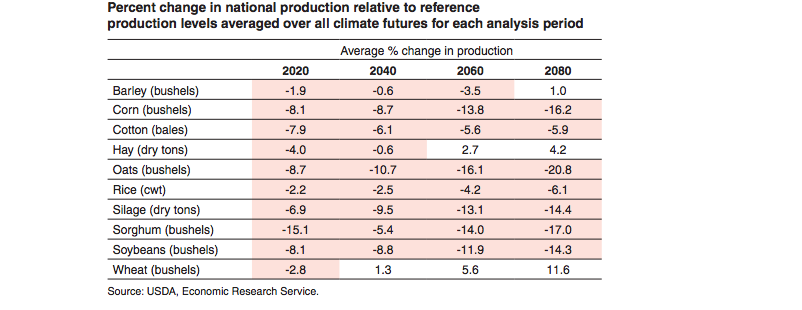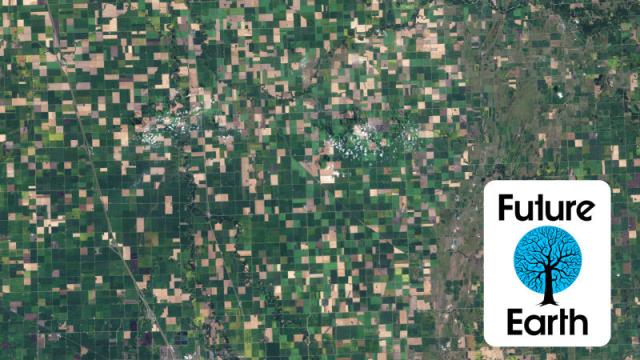America has a huge, sprawling, incredibly productive agricultural system, the slow-grown product of its history as a farming nation. But that system has already begun changing — and what Americans growing on those farms is going to change dramatically too.
The Climate of the Future
Using nine different climate future scenarios, the USDA recently put together a series of projections for what American farming might look like 25, 45, and 65 years in the future. Among those findings: America is very likely to steadily lose irrigated farmland, to the tune of several million acres spread across the decades.
Exactly how many acres would be lost depends on which climate scenario you’re looking at: some imagine an improvement in emissions, others assume no change, and still others assume a worsening scenario. But enormous loss was a constant in almost all of the scenarios considered, as you can see in this chart:

Unseating King Corn With Wheat
So what does this loss mean in terms of individual crops? It means that farms as Americans know them are about to change. As corn production steadily falls, a new challenger is going to rise from the dust. America’s new farm overlord will be wheat.
At first, wheat will join all other crops in a nosedive around 2020. But — while corn, oats, sorghum, and soy keep falling further — something curious will happen to wheat. It’s projected to level off and then rise quickly.
Why wheat and not corn?
Part of it is because the hammer is not going to fall on all geographic areas equally. The American Cornbelt is going to be particularly hard hit by a temperature rise that will be responsible for a lot of the corn loss we see. But just as important are the different ways the two crops are likely to react to an atmosphere full of much more carbon emissions than we have now. Something curious happens to wheat in an increased carbon scenario: photosythesis actually increases. Corn has no increase. Wheat would still be limited by water shortages, but the boost in photosynthesis does give it a small advantage over other crops.
Of course, even with corn heading on a sharp downward slope and wheat steadily rising, we wouldn’t see an immediate shift. This year, American farmers grew just under 89 million acres of corn and only 56 million acres of wheat. Instead, what we have to look forward to is a slow gradual dethroning, picking up speed through the decades.
In 2020, corn will have enough of a headstart that it will still rule the farm. Plus, wheat will also have taken a bit of a dip by that point too. But by 2080, with corn projections continuing to fall and wheat not only having recovered from its break, but rapidly gaining, the field — and its winners — has shifted.

Where We’re Going We Don’t Need Lawns
Corn’s top spot in America has always been a bit of a polite fiction. While corn is certainly the number one food crop grown on irrigated land in the US, the actual number one crop is people’s lawns.
Why is that quirk of US agriculture so important? Because it also gives us a clue of where Americans might go next — and what they should do when they get there.
Another way to look at the crops of the future is to look not at individual changes but at the total yield of all crops together — and how it will differ from what the US has now. The USDA projects that the average yield of all crops will go down by 2080. Pair that with rising population projections from other agencies, and we’ve got ourselves a problem.
So how do we solve it?
As the climate changes and crop yields fall, priorities are going to change — one visible change we’ll see (and are already starting to see in drought-stricken parts of the US West and Southwest) is the death of the lawn as we funnel those resources elsewhere. The full scope of changes is going to be much bigger, though.
Climate change is going to affect so much more than just temperatures and water availability. In addition, farmers will face a landscape that could also include a change in soil fertility, the rise of different agricultural pests and diseases, plus a smoggier atmosphere, and less ozone to shield us.
The good news is that farmers have already begun to figure out ways to do more with less land and resources. As the climate changes, we’re only going to need to do more of that.
We’re going to need to keep searching for higher yield crop varieties, improve the technology on our farms, and figure out the best planting schedules for our shifting seasons. Perhaps the most important change will be to adapt drought-farming techniques. The farms of the future will, no doubt, look different both in what they produce and how they do it — but what won’t change is how much we need and depend on them.
